
What do the numbers mean? A survey is administered by a marketing firm. Two of the people surveyed are Brenda and Jason. Three of the questions are as follows:
- Do you favor the construction of a new shopping mall?
- How many cars do you own?
- What is your marital slams?
(1) Strongly oppose (2) Somewhat oppose (3) Neutral (4) Somewhat favor (5) Strongly favor
(1) Married (2) Single (3) Divorced (4) Domestically partnered (5) Other
- Are the responses for question (i) nominal or ordinal?
- On question (i), Brenda answers (2) and Jason answers (4). Jason’s answer (4) is greater than Brenda’s answer (2). Does Jason’s answer reflect more of something?
- Jason’s answer to question (i) is twice as large as Brenda’s answer. Does Jason’s answer reflect twice as much of something? Explain.
- Are the responses for question (ii) qualitative or quantitative?
- On question (ii). Brenda answers 2 and Jason answers 1. Does Brenda’s answer reflect more of something? Does Brenda’s answer reflect twice as much of something? Explain.
- Are the responses for question (iii) nominal or ordinal?
- On question (iii). Brenda answers (4) and Jason answers (2). Does Brenda’s answer reflect more of something? Does Brenda’s answer reflect twice as much of something? Explain.
a.
To identify:whether the responses for question (i) nominal or ordinal.
Answer to Problem 49E
The responses for question (i): ordinal.
Explanation of Solution
Given information:A survey is administered by a marketing firm. Two of the people surveyed are Brenda and Jason. Three of the questions are as follows:
Do you favor the construction of a new shopping mall?
(1) Strongly oppose (2) Somewhat oppose (3) Neutral (4) Somewhat favor (5) Strongly favor
ii. How many cars do you own?
iii. What is your marital status?
(1) Married (2) Single (3) Divorced (4) Domestically partnered (5) Other
Concept Involved:
There are various methods of collecting information by sampling. Once the information has been collected, the collection is called a data set. Variables can be divided into two types: qualitative and quantitative. Qualitative variables are also called categorical variable, classify individuals into categories. Quantitative variables are numerical and tell how much of something there is.
Qualitative variables come in two types: ordinal variables and nominal variables.
Ordinal variables are qualitative variables whose categories have a natural ordering.
Nominal variables are qualitative variables whose categories have no natural ordering.
Quantitative variables can be either discrete or continuous.
Discrete variables are those whose possible values can be listed. Often, discrete variables result from counting something, so the possible values of the variable are 0, 1, 2 and so forth.
Continuous variables can, in principle, take on any value within some interval.

The values are classified into categories in a nominal variable, but no natural ordering is there in categories, whereas, the values are also classified into categories in an ordinary variablebut a natural ordering is there in categories.
Thus, to given question the choices for response has natural ordering with strongly oppose which indicating negative opinion and favor stating intensely positive feedback is ordinal variable.
Therefore, responses to given question are ordinal.
b.
To identify:Whether Jason’s answer reflects more of something.
Answer to Problem 49E
Jason’s answer reflects that he is favor of constructing a new shopping mall unlike Brenda
Explanation of Solution
Given information: A survey is administered by a marketing firm. Two of the people surveyed are Brenda and Jason. Three of the questions are as follows:
i. Do you favor the construction of a new shopping mall?
(1) Strongly oppose (2) Somewhat oppose (3) Neutral (4) Somewhat favor (5) Strongly favor
ii. How many cars do you own?
iii. What is your marital status?
(1) Married (2) Single (3) Divorced (4) Domestically partnered (5) Other
On question (i), Brenda answers (2) and Jason answers (4). Jason’s answer (4) is greater than Brenda’s answer (2).
Concept Involved:
There are various methods of collecting information by sampling. Once the information has been collected, the collection is called a data set. Variables can be divided into two types: qualitative and quantitative. Qualitative variables are also called categorical variable, classify individuals into categories. Quantitative variables are numerical and tell how much of something there is.
Qualitative variables come in two types: ordinal variables and nominal variables.
Ordinal variables are qualitative variables whose categories have a natural ordering.
Nominal variables are qualitative variables whose categories have no natural ordering.
Quantitative variables can be either discrete or continuous.
Discrete variables are those whose possible values can be listed. Often, discrete variables result from counting something, so the possible values of the variable are 0, 1, 2 and so forth.
Continuous variables can, in principle, take on any value within some interval.
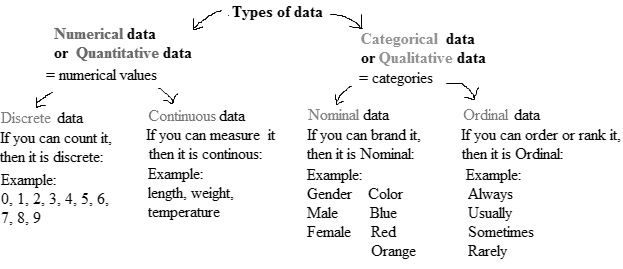
It is given that Brenda answered 2 and Jason answered 4. Thus Jason’s answer reflect more of positivity, as he though not sure of intensity of favoring the construction supported it, unlike Brenda.
c.
To identify:Whether Jason’s answer reflects twice as much of something.
Answer to Problem 49E
The variable response to given question is categorical in nature, so it doesn’t not imply Jason’s answer to given question is twice as much of something
Explanation of Solution
Given information: A survey is administered by a marketing firm. Two of the people surveyed are Brenda and Jason. Three of the questions are as follows:
i. Do you favor the construction of a new shopping mall?
(1) Strongly oppose (2) Somewhat oppose (3) Neutral (4) Somewhat favor (5) Strongly favor
ii. How many cars do you own?
iii. What is your marital status?
(1) Married (2) Single (3) Divorced (4) Domestically partnered (5) Other
Jason’s answer to question (i) is twice as large as Brenda’s answer.
Concept Involved:
There are various methods of collecting information by sampling. Once the information has been collected, the collection is called a data set. Variables can be divided into two types: qualitative and quantitative. Qualitative variables are also called categorical variable, classify individuals into categories. Quantitative variables are numerical and tell how much of something there is.
Qualitative variables come in two types: ordinal variables and nominal variables.
Ordinal variables are qualitative variables whose categories have a natural ordering.
Nominal variables are qualitative variables whose categories have no natural ordering.
Quantitative variables can be either discrete or continuous.
Discrete variables are those whose possible values can be listed. Often, discrete variables result from counting something, so the possible values of the variable are 0, 1, 2 and so forth.
Continuous variables can, in principle, take on any value within some interval.
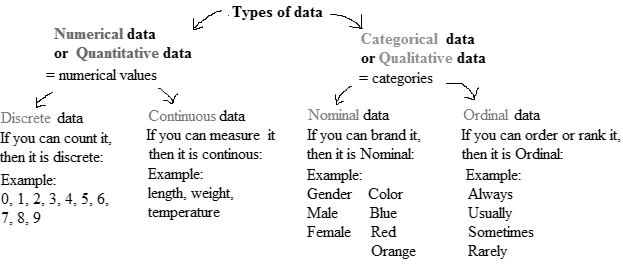
It is given that Brenda answered 2 and Jason answered 4. Thus Jason’s answer reflect more of positivity, as he though not sure of intensity of favoring the construction supported it, unlike Brenda. It is given Jason’s answer to given question is twice as large as Brenda, which does not implies twice as much of something, because, the variable response to given question is categorical in nature.
d.
To identify:Whether question (ii) qualitative or quantitative.
Answer to Problem 49E
The responses for question (ii): quantitative
Explanation of Solution
Given information: A survey is administered by a marketing firm. Two of the people surveyed are Brenda and Jason. Three of the questions are as follows:
i. Do you favor the construction of a new shopping mall?
(1) Strongly oppose (2) Somewhat oppose (3) Neutral (4) Somewhat favor (5) Strongly favor
ii. How many cars do you own?
iii. What is your marital status?
(1) Married (2) Single (3) Divorced (4) Domestically partnered (5) Other
Concept Involved:
There are various methods of collecting information by sampling. Once the information has been collected, the collection is called a data set. Variables can be divided into two types: qualitative and quantitative. Qualitative variables are also called categorical variable, classify individuals into categories. Quantitative variables are numerical and tell how much of something there is.
Qualitative variables come in two types: ordinal variables and nominal variables.
Ordinal variables are qualitative variables whose categories have a natural ordering.
Nominal variables are qualitative variables whose categories have no natural ordering.
Quantitative variables can be either discrete or continuous.
Discrete variables are those whose possible values can be listed. Often, discrete variables result from counting something, so the possible values of the variable are 0, 1, 2 and so forth.
Continuous variables can, in principle, take on any value within some interval.
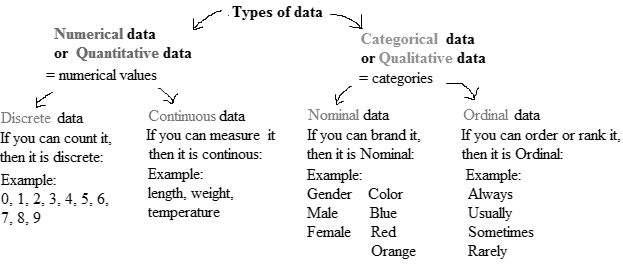
The variable which classifies individuals into categories is called qualitative variable, and the variable whichprovide information aboutquantity or number of something is quantitative variable. The variable number of cars owned by one tells how many cars one had been capable of possessing.
Therefore, the response is quantitative in nature.
e.
To identify:Whether Brenda’s answer reflect more of something and does it reflect Brenda’s answer is twice as much as something.
Answer to Problem 49E
The response is quantitative, Brenda’s answer reflect that she have more cars than Jason.
Yes! Brenda’s answer reflect that she have twice as many cars as what Jason have.
Explanation of Solution
Given information: A survey is administered by a marketing firm. Two of the people surveyed are Brenda and Jason. Three of the questions are as follows:
i. Do you favor the construction of a new shopping mall?
(1) Strongly oppose (2) Somewhat oppose (3) Neutral (4) Somewhat favor (5) Strongly favor
ii. How many cars do you own?
iii. What is your marital status?
(1) Married (2) Single (3) Divorced (4) Domestically partnered (5) Other
On question (ii), Brenda answers 2 and Jason answers 1.
Concept Involved:
There are various methods of collecting information by sampling. Once the information has been collected, the collection is called a data set. Variables can be divided into two types: qualitative and quantitative. Qualitative variables are also called categorical variable, classify individuals into categories. Quantitative variables are numerical and tell how much of something there is.
Qualitative variables come in two types: ordinal variables and nominal variables.
Ordinal variables are qualitative variables whose categories have a natural ordering.
Nominal variables are qualitative variables whose categories have no natural ordering.
Quantitative variables can be either discrete or continuous.
Discrete variables are those whose possible values can be listed. Often, discrete variables result from counting something, so the possible values of the variable are 0, 1, 2 and so forth.
Continuous variables can, in principle, take on any value within some interval.
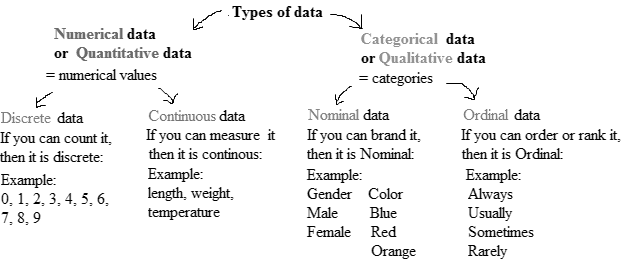
It is given that Brenda answered 2 and Jason answered 1 in response to given question, which clearly implies Brenda owns more cars than Jason. Brenda’s answer reflects twice as much as cars than Jason.
f.
To identify:Whether the responses to question (iii) nominal or ordinal.
Answer to Problem 49E
The responses to question (iii): nominal.
Explanation of Solution
Given information: A survey is administered by a marketing firm. Two of the people surveyed are Brenda and Jason. Three of the questions are as follows:
i. Do you favor the construction of a new shopping mall?
(1) Strongly oppose (2) Somewhat oppose (3) Neutral (4) Somewhat favor (5) Strongly favor
ii. How many cars do you own?
iii. What is your marital status?
(1) Married (2) Single (3) Divorced (4) Domestically partnered (5) Other
Concept Involved:
There are various methods of collecting information by sampling. Once the information has been collected, the collection is called a data set. Variables can be divided into two types: qualitative and quantitative. Qualitative variables are also called categorical variable, classify individuals into categories. Quantitative variables are numerical and tell how much of something there is.
Qualitative variables come in two types: ordinal variables and nominal variables.
Ordinal variables are qualitative variables whose categories have a natural ordering.
Nominal variables are qualitative variables whose categories have no natural ordering.
Quantitative variables can be either discrete or continuous.
Discrete variables are those whose possible values can be listed. Often, discrete variables result from counting something, so the possible values of the variable are 0, 1, 2 and so forth.
Continuous variables can, in principle, take on any value within some interval.
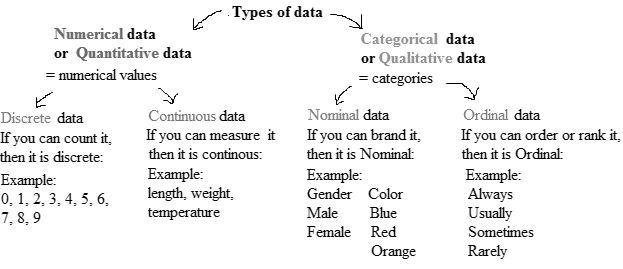
The values are classified into categories in a nominal variable, but no natural ordering is there in categories, whereas, the values are also classified into categories in an ordinary variable but a natural ordering is there in categories.
Thus, the responses to given question classifies one’s marital status into five categories.
Therefore, responses to given question are nominal.
g.
To identify:Whether Brenda’s answers reflect more of something and reflect twice as much as something.
Answer to Problem 49E
Brenda’s response of 4 and Jason’s response of 2 do not reflect more of something. Brenda’s answer does not reflect twice as much as Jason’s.
Explanation of Solution
Given information: A survey is administered by a marketing firm. Two of the people surveyed are Brenda and Jason. Three of the questions are as follows:
i. Do you favor the construction of a new shopping mall?
(1) Strongly oppose (2) Somewhat oppose (3) Neutral (4) Somewhat favor (5) Strongly favor
ii. How many cars do you own?
iii. What is your marital status?
- Married (2) Single (3) Divorced (4) Domestically partnered (5) Other On question (iii), Brenda answers (4) and Jason answers (2).
Concept Involved:
There are various methods of collecting information by sampling. Once the information has been collected, the collection is called a data set. Variables can be divided into two types: qualitative and quantitative. Qualitative variables are also called categorical variable, classify individuals into categories. Quantitative variables are numerical and tell how much of something there is.
Qualitative variables come in two types: ordinal variables and nominal variables.
Ordinal variables are qualitative variables whose categories have a natural ordering.
Nominal variables are qualitative variables whose categories have no natural ordering.
Quantitative variables can be either discrete or continuous.
Discrete variables are those whose possible values can be listed. Often, discrete variables result from counting something, so the possible values of the variable are 0, 1, 2 and so forth.
Continuous variables can, in principle, take on any value within some interval.

The values are classified into categories in a nominal variable, but no natural ordering is there in categories, whereas, the values are also classified into categories in an ordinary variable but a natural ordering is there in categories.
Thus, the responses to given question classifies one’s marital status into five categories.
Response to Marital status are nominal in nature, thus primarily the variable marital status is categorical. Hence, Brenda’s response of 4 and Jason’s response of 2 do not reflect more of something.
Therefore, Brenda’s answer does not reflect twice as much as Jason’s
Want to see more full solutions like this?
Chapter 1 Solutions
Elementary Statistics ( 3rd International Edition ) Isbn:9781260092561
 Holt Mcdougal Larson Pre-algebra: Student Edition...AlgebraISBN:9780547587776Author:HOLT MCDOUGALPublisher:HOLT MCDOUGAL
Holt Mcdougal Larson Pre-algebra: Student Edition...AlgebraISBN:9780547587776Author:HOLT MCDOUGALPublisher:HOLT MCDOUGAL Glencoe Algebra 1, Student Edition, 9780079039897...AlgebraISBN:9780079039897Author:CarterPublisher:McGraw Hill
Glencoe Algebra 1, Student Edition, 9780079039897...AlgebraISBN:9780079039897Author:CarterPublisher:McGraw Hill Functions and Change: A Modeling Approach to Coll...AlgebraISBN:9781337111348Author:Bruce Crauder, Benny Evans, Alan NoellPublisher:Cengage Learning
Functions and Change: A Modeling Approach to Coll...AlgebraISBN:9781337111348Author:Bruce Crauder, Benny Evans, Alan NoellPublisher:Cengage Learning Big Ideas Math A Bridge To Success Algebra 1: Stu...AlgebraISBN:9781680331141Author:HOUGHTON MIFFLIN HARCOURTPublisher:Houghton Mifflin Harcourt
Big Ideas Math A Bridge To Success Algebra 1: Stu...AlgebraISBN:9781680331141Author:HOUGHTON MIFFLIN HARCOURTPublisher:Houghton Mifflin Harcourt Algebra: Structure And Method, Book 1AlgebraISBN:9780395977224Author:Richard G. Brown, Mary P. Dolciani, Robert H. Sorgenfrey, William L. ColePublisher:McDougal Littell
Algebra: Structure And Method, Book 1AlgebraISBN:9780395977224Author:Richard G. Brown, Mary P. Dolciani, Robert H. Sorgenfrey, William L. ColePublisher:McDougal Littell




